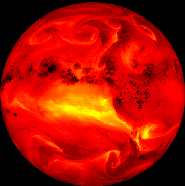
Infrared is usually divided into 3 spectral regions: near, mid and far-infrared. The boundaries between the near, mid and far-infrared regions are not agreed upon and can vary. The main factor that determines which wavelengths are included in each of these three infrared regions is the type of detector technology used for gathering infrared light.
Near-infrared observations have been made from ground based observatories since the 1960's. They are done in much the same way as visible light observations for wavelengths less than 1 micron, but require special infrared detectors beyond 1 micron. Mid and far-infrared observations can only be made by observatories which can get above our atmosphere. These observations require the use of special cooled detectors containing crystals like germanium whose electrical resistance is very sensitive to heat.
Infrared radiation is emitted by any object that has a temperature (ie radiates heat). So, basically all celestial objects emit some infrared. The wavelength at which an object radiates most intensely depends on its temperature. In general, as the temperature of an object cools, it shows up more prominently at farther infrared wavelengths. This means that some infrared wavelengths are better suited for studying certain objects than others.
NEAR INFRARED:
Near-infrared observations have been made from ground based observatories since the 1960's. They are done in much the same way as visible light observations for wavelengths less than 1 micron, but require special infrared detectors beyond 1 micron. Mid and far-infrared observations can only be made by observatories which can get above our atmosphere. These observations require the use of special cooled detectors containing crystals like germanium whose electrical resistance is very sensitive to heat.
Infrared radiation is emitted by any object that has a temperature (ie radiates heat). So, basically all celestial objects emit some infrared. The wavelength at which an object radiates most intensely depends on its temperature. In general, as the temperature of an object cools, it shows up more prominently at farther infrared wavelengths. This means that some infrared wavelengths are better suited for studying certain objects than others.
NEAR INFRARED:

[Above: Visible (L) and Near-Infrared (R) View of the Galactic Center]
As we move away from visible light towards longer wavelengths of light, we enter the infrared region. As we enter the near-infrared region, the hot blue stars seen clearly in visible light fade out and cooler stars come into view. Large red giant stars and low mass red dwarfs dominate in the near-infrared. The near-infrared is also the region where interstellar dust is the most transparent to infrared light.
MID INFRARED:
MID INFRARED:

[Above: Mid Infrared View of the Earth]
As we enter the mid-infrared region of the spectrum, the cool stars begin to fade out and cooler objects such as planets, comets and asteroids come into view. Planets absorb light from the sun and heat up. They then re-radiate this heat as infrared light. This is different from the visible light that we see from the planets which is reflected sunlight. The planets in our solar system have temperatures ranging from about 53 to 573 degrees Kelvin. Objects in this temperature range emit most of their light in the mid-infrared. For example, the Earth itself radiates most strongly at about 10 microns. Asteroids also emit most of their light in the mid-infrared making this wavelength band the most efficient for locating dark asteroids. Infrared data can help to determine the surface composition, and diameter of asteroids.
FAR INFRARED:
FAR INFRARED:

[Above: Milky Way Galaxy in the Far Infrared]
In the far-infrared, the stars have all vanished. Instead we now see very cold matter (140 Kelvin or less). Huge, cold clouds of gas and dust in our own galaxy, as well as in nearby galaxies, glow in far-infrared light. In some of these clouds, new stars are just beginning to form. Far-infrared observations can detect these protostars long before they "turn on" visibly by sensing the heat they radiate as they contract."
Learn more...

![Reblog this post [with Zemanta]](http://img.zemanta.com/reblog_c.png?x-id=5ee8501b-62bb-4e4b-b464-182e7b9a53d1)




.png)





No comments:
Post a Comment